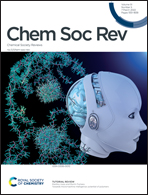Fluorescent probe strategy for live cell distinction
Abstract
Live cell discrimination is the first and essential step to understand complex biosystems. Conventional cell discrimination involving various antibodies relies on selective surface biomarkers. Compared to antibodies, the fluorescent probe strategy allows the utilisation of intracellular biomarkers, providing broader options with unique chemical principles to achieve the live cell distinction. In general, fluorescent probes can be retained in cells by interacting with biomolecules, accumulating via transporters, and participating in metabolism. Based on the target difference, fluorescent probe strategy can be divided into several categories: protein-oriented live cell distinction (POLD), carbohydrate-oriented live cell distinction (COLD), DNA-oriented live cell distinction (DOLD), gating-oriented live cell distinction (GOLD), metabolism-oriented live cell distinction (MOLD) and lipid-oriented live cell distinction (LOLD). In this review, we will outline the concepts and mechanisms of different strategies, introduce their applications in cell-type discrimination, and discuss their advantages and challenges in this area. We expect this tutorial will provide a new perspective on the mechanisms of fluorescent probe strategy and facilitate the development of cell-type-specific probes.



 Please wait while we load your content...
Please wait while we load your content...